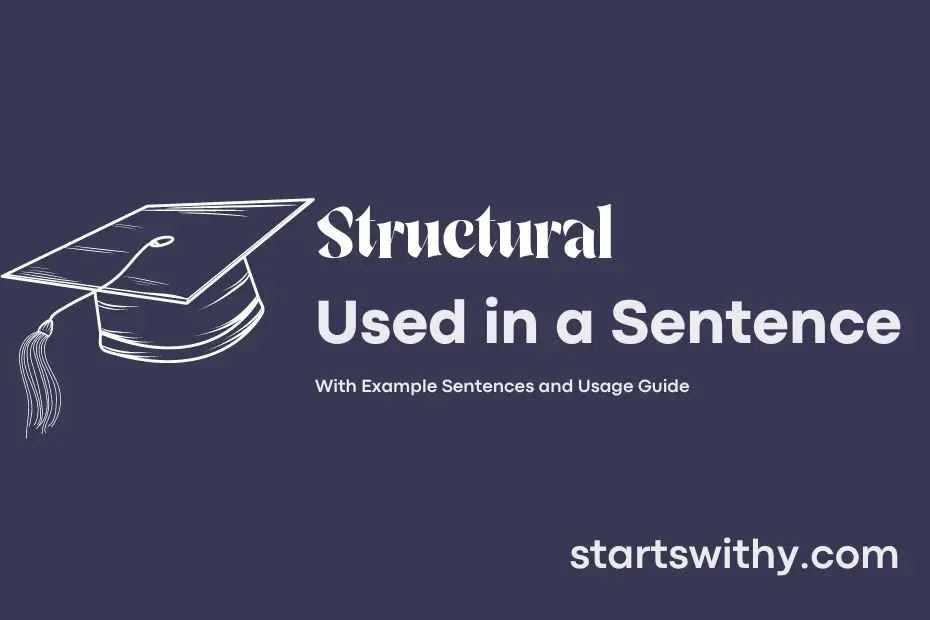Have you ever wondered what the term “structural” means in the context of writing or linguistics? In language studies, the term “structural” refers to the organization and arrangement of elements within a sentence or a larger piece of writing.
When we discuss the “structural” aspect of language, we’re examining how sentences are constructed, how ideas are connected, and how information is presented to create a coherent and meaningful communication. Understanding the structural elements in writing can help writers convey their ideas effectively and ensure that their message is clear and cohesive.
7 Examples Of Structural Used In a Sentence For Kids
- Structural engineers design buildings and bridges.
- Our bones provide structural support for our bodies.
- A spider’s web is a structural form it creates to catch insects.
- A beehive has a structural organization with different roles for each bee.
- A tree’s branches have a structural pattern that helps it grow strong.
- Lego blocks can be put together in different structural arrangements to build things.
- Ants work together to create structural tunnels in the ground.
14 Sentences with Structural Examples
- Structural engineering is crucial for designing safe and reliable buildings.
- Students often struggle with understanding the structural components of complex mathematical equations.
- It’s common for college projects to require a clear structural plan before execution.
- The structural integrity of a bridge is always a major concern in civil engineering.
- The structural layout of a research paper is just as important as its content.
- Understanding the structural organization of a company is essential in business management.
- Structural analysis software is widely used in engineering courses to simulate real-world scenarios.
- Developing a strong structural foundation in subjects like physics can help with advanced studies.
- In architecture classes, students learn how to balance aesthetics with structural stability.
- A well-thought-out structural approach to study habits can greatly impact academic success.
- The structural framework of a computer program is just as important as its functionality.
- Examining the structural changes in society over time can lead to a better understanding of history.
- Students studying anthropology often analyze the structural organization of different cultural practices.
- Designing a structural outline before writing an essay can make the writing process more efficient.
How To Use Structural in Sentences?
Structural is an adjective that is used to describe something related to the arrangement or organization of the parts of a whole. When incorporating this word into a sentence, it is important to keep in mind its meaning and usage.
Example sentence: The structural integrity of the building was compromised after the earthquake.
In this sentence, the word “structural” is used to convey information about the condition of the building. It highlights the arrangement and stability of its components.
To effectively use structural in a sentence, consider the context in which you are writing and ensure it is being used correctly. Pay attention to the relationship between the parts of a whole and how they contribute to the overall composition. This will help you accurately convey the intended meaning of your sentence.
As you become more familiar with using structural in sentences, you can experiment with different sentence structures and contexts to further enhance your understanding of the word. Remember to always consider the meaning of the word and how it fits within the context of your writing. With practice, you will become more confident in incorporating structural into your sentences effectively.
Conclusion
In conclusion, sentences with structural variations can enhance the clarity, depth, and impact of written communication. By altering the arrangement of words, phrases, and clauses within a sentence, writers can emphasize key points, create different tones, and engage readers in a more dynamic way. Structural variations allow for a more creative and expressive use of language, enabling writers to craft sentences that are both engaging and effective in delivering their intended message.
Whether it’s using parallel structures for balance and repetition, employing varied sentence lengths for rhythm, or incorporating different types of clauses for complexity, mastering the art of structural variations can elevate the quality of writing and make it more engaging for readers. By experimenting with different sentence structures, writers can enhance the overall cohesiveness and impact of their work, ultimately leading to more compelling and engaging written content.



